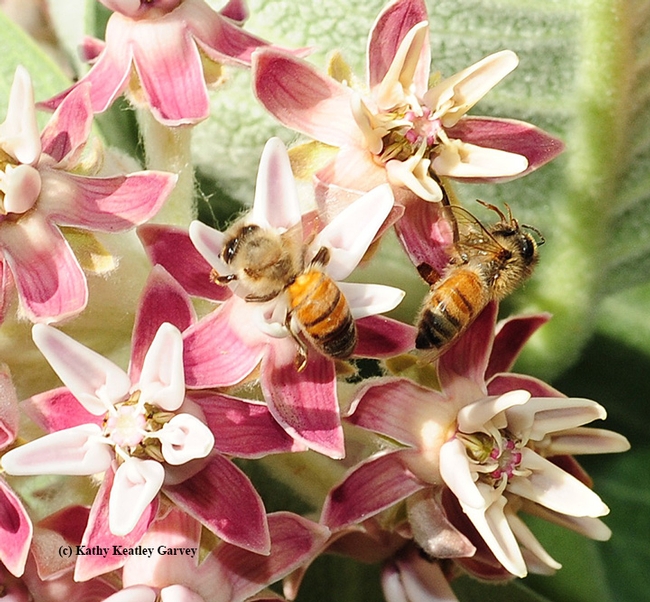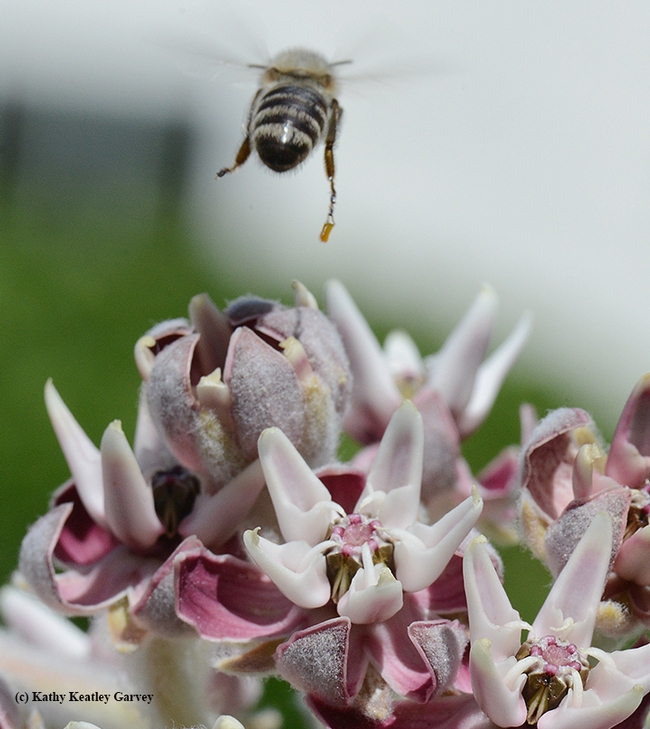- Author: Kathy Keatley Garvey
Hey, wait, take me with you!
No, leave me alone! Let me go!
Have you ever seen insects struggling to free themselves from the reproductive chamber of a milkweed blossom?
Instead of producing loose pollen grains, milkweeds produce pollinia, a waxy, sticky packet of golden pollen grains originating from a single anther. When bees and other insects forage for nectar in the "nectar troughs," where the pollinia are, they emerge with wishbone-shaped pollinia on their feet or other body parts. That is, if they emerge at all. Sometimes they die there; the reproductive chamber becomes a floral death trap.
What may seem like nature's appalling act of cruelty is actually a unique case of floral pollination, the transfer of pollina from one blossom to another.
"Milkweed flowers bloom in umbels which are clusters of individual flowers on stems that emerge from a common point," explains Eric Eldredge in an article published by the U.S. Department of Agriculture's Natural Resources Conservation Service. "Flowers of different species of milkweed differ in size, color, and fragrance, but all produce their pollen in waxy sacs called pollinia. The pollinia are located in two anther pouches adjacent to vertical stigmatic slits of the flowers. Pairs of adjacent pollinia are connected to each other by translator arms from a clamp located in the middle, called the corpusculum (Bookman, 1981). The complete structure is called a pollinarium."
"Insects that visit a flower to drink nectar struggle to grasp the slippery surfaces and may accidentally slip their leg, tarsus, mouthpart, or other appendage into the opening at the bottom of the stigmatic slit. This slit is formed by guide rails, which are lined with bristles that prevent the insect moving its appendage any direction but up. The top of the slit leads into the opening of the corpusculum, which has hard, sharp inside edges that taper together at the top. The corpusculum clamps firmly to the insect by pinching onto the insect's appendage. In its struggles to escape, if the insect is large enough, it can withdraw the paired pollinia from the anther pouches and fly away."
We've seen dead honey bees trapped in the milkweed blossoms while other bees forage around their carcasses. And then we've seen the frantic struggles (below). Fortunately this bee in the first three photos escaped. Another bee did not.
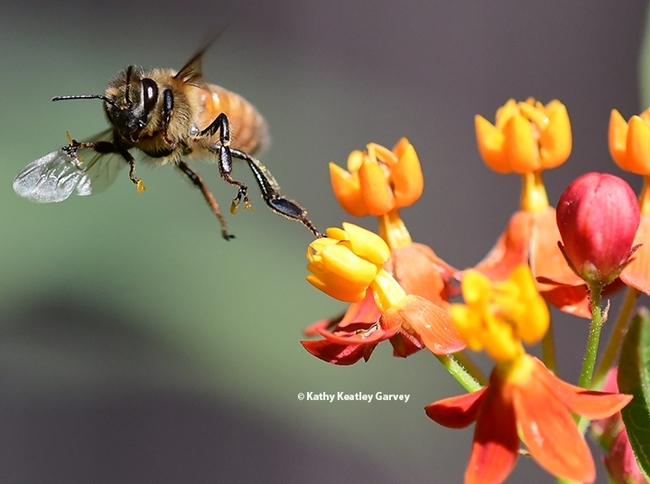
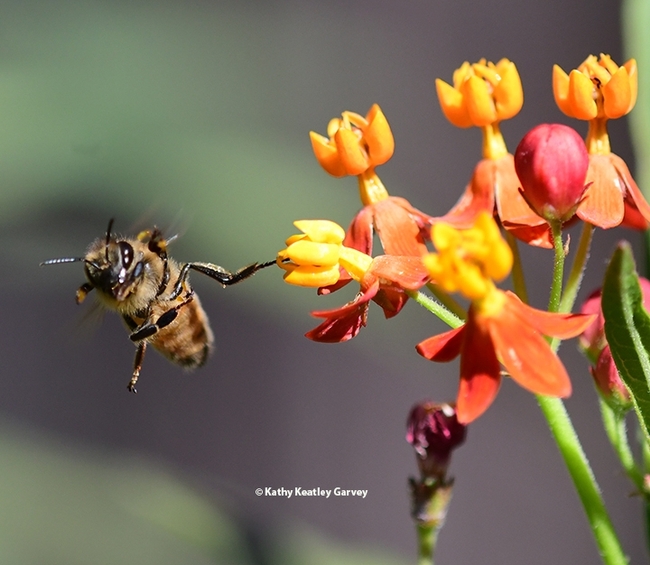
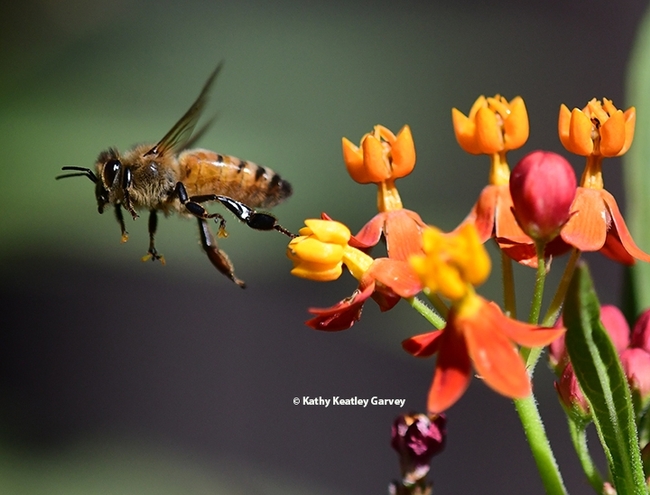
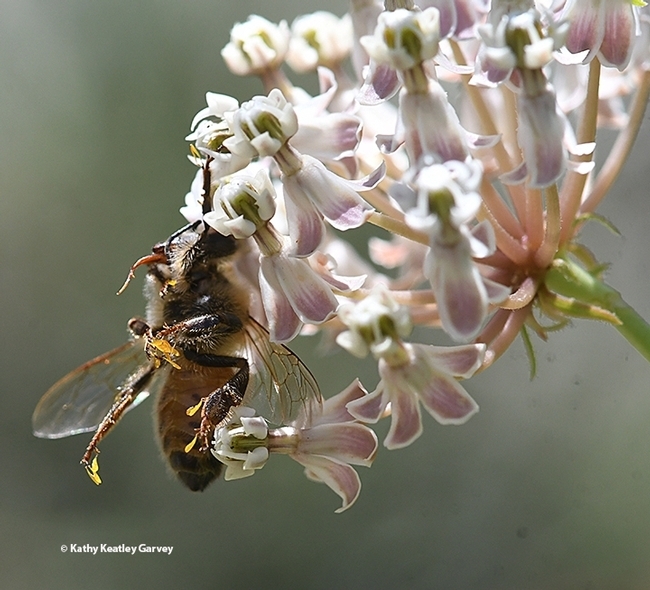
- Author: Kathy Keatley Garvey
It is not a "pretty sight," as Ernest Hemingway might have said, to see a honey bee stuck like glue--nature's "gorilla glue?"-in the reproductive chamber of a milkweed.
It's a trap, a floral trap.
If you've never seen this, this is how it works: milkweed produces pollinia, a sticky structure or packet of pollen grains originating from a single anther (male part). During the flower's complex pollination process, the mass is transferred as a single unit and looks like a yellow wishbone dangling on a honey bee's legs or other parts of her anatomy. It's a devious way for the milkweed to force insects to help them reproduce--in exchange for the sweet nectar reward. (Orchids produce pollinia, too.)
Oh, the nectar is so enticing! Honey bees (and other insects) literally make a bee-line for the it. They buzz and bump around as they await a vacancy. The scenario almost calls for crowd control or at least traffic lights.
But it's a trap, a floral trap. Sometimes you'll see frenzied bees struggling to free themselves from the sticky nectar trough. They are not always successful. Return to the scene of the grime and you'll see insect parts or whole insects trapped in the sticky mass. Dead.
The two honey bees below experienced different fates on this narrow-leafed milkweed, Asclepias fascicularis. One managed to free her leg from the grip of the milkweed reproductive chamber and return to her colony, complete with the precious nectar--and legs intact. The other did not. The meal was her last.
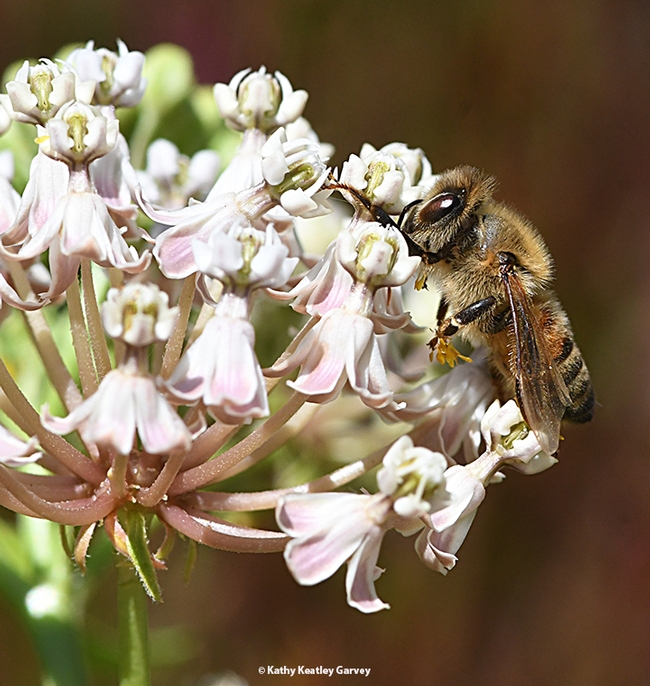
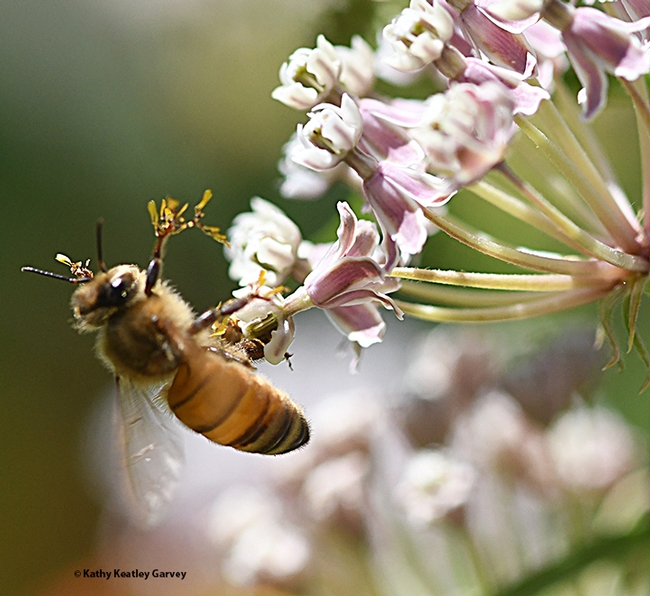
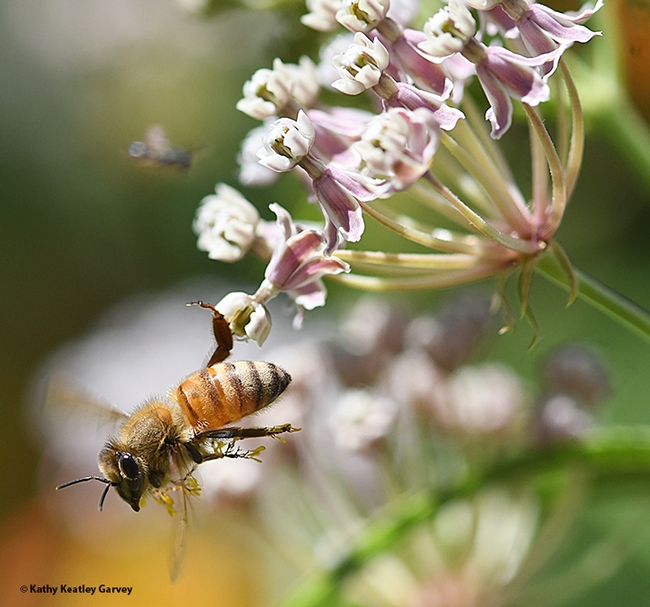
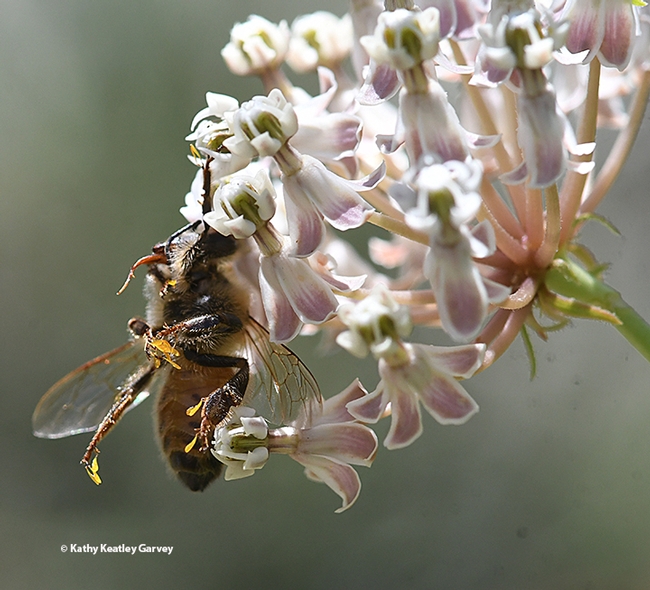
- Author: Kathy Keatley Garvey
If you've ever stepped in sticky gum, it's similar to what happens when an insect steps into milkweed pollinia.
Take the wasps visiting the tropical milkweed (Asclepias curassavica) on Thursday morning, July 16 in the UC Davis Arboretum and Public Garden.
They foraged on the colorful red, yellow and orange blossoms, and as nature intended (for reproductive reasons), flew off with that sticky pollinia from the anthers.
Basically, pollinia is a sticky packet of golden pollen grains originating from a single anther. The wishbone-shaped pollinia are in a nectar trough where insects often get trapped. Some insects manage to escape but leave body parts behind. A foot here...a wing there...an antenna over there...
One wasp exited a flower with "the golden glue" on its feet.
“Too funny with all the milkweed pollinia all over its feet,” commented Lynn Kimsey, director of the Bohart Museum of Entomology and Nematology and professor of entomology at UC Davis, who identified the wasp as a species of Podalonia, parasitoidal wasps in the family Sphecidae. "It looks like it's wearing fluffy socks.”
We've seen honey bees on showy milkweed (Asclepias speciosa) struggling to free themselves, only to find the bees dead the next day--and new recruits buzzing in for their share.
These Podalonia wasps, however, managed to navigate the "traps" quite well.
They'll be back for another round.
(Reminder: Folks planting the tropical milkweed in temperate zones (like here in Davis, Calif.) must remove or cut back the tropical milkweed by winter. "A protozoan parasite of monarch butterflies, Ophryocystis elektroscirrha or OE for short, can travel with monarchs visiting the plants and become deposited on leaves," explains the Xerces Society for Invertebrate Conservation.)
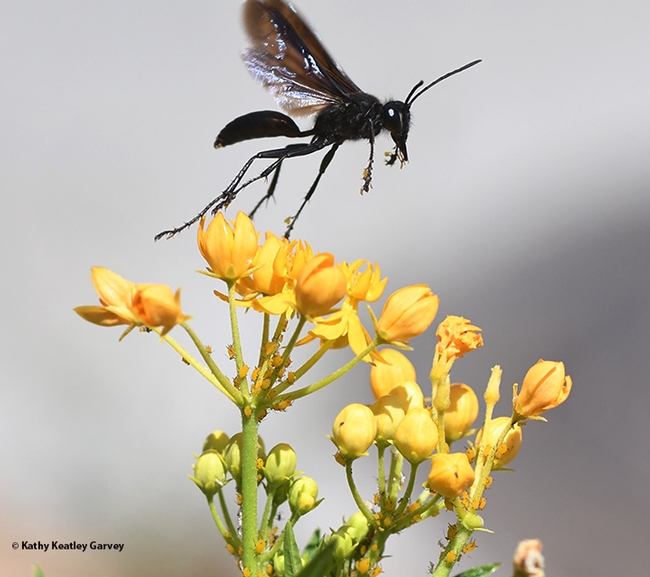
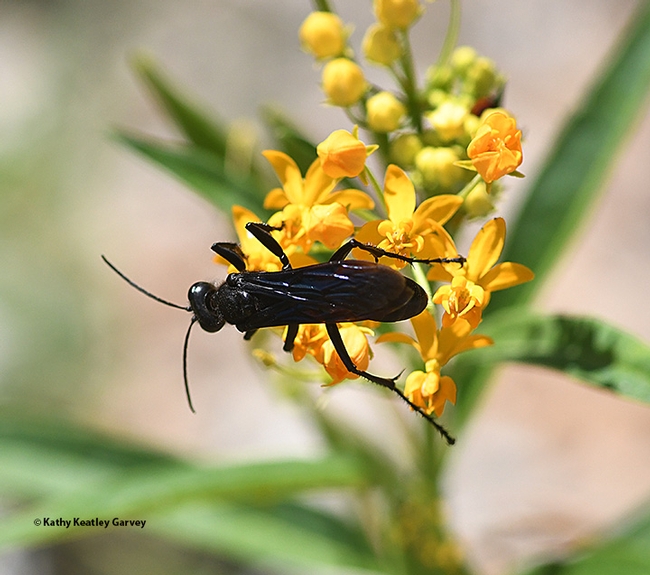
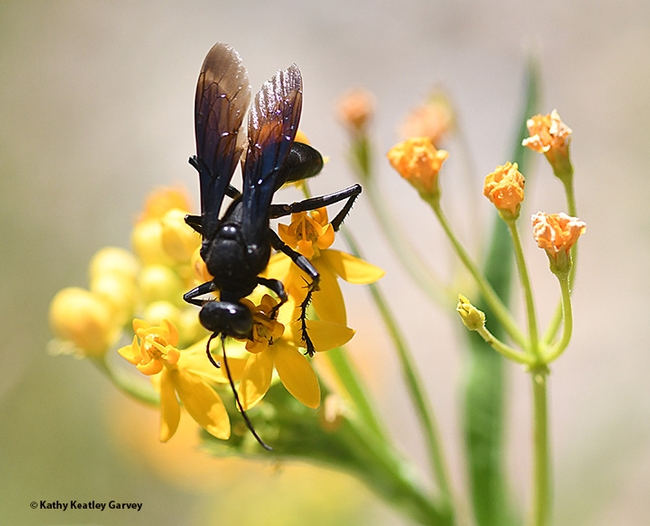
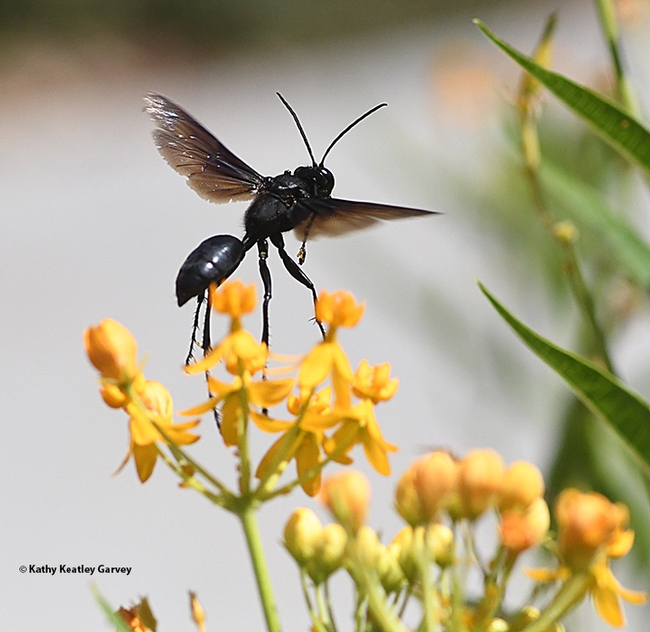
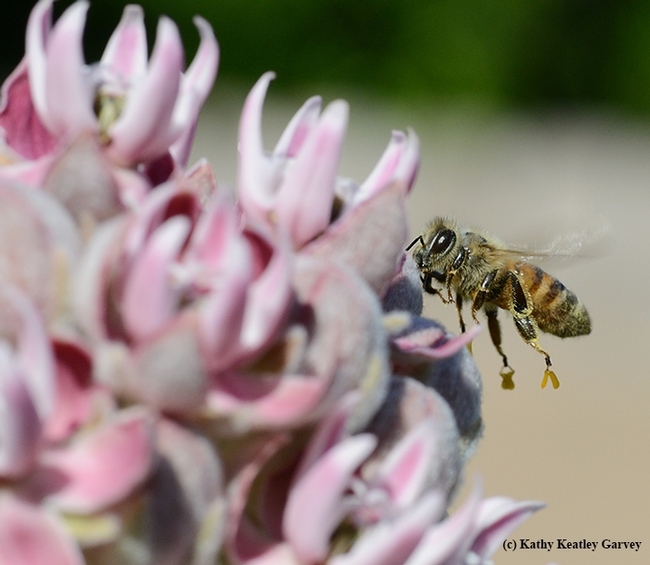
- Author: Kathy Keatley Garvey
So here's this tattered old worker bee seeking some nectar from the broadleaf milkweed, Asclepias speciosa. She looks as if she's not only been around the block a few times but around the county several dozen times. Her wings look too ragged to support her flight back to her colony. She'll probably live just a few more days. Worker bees live only four to six weeks in the peak season, and this is the peak season.
She bends her head and sips nectar, only to realize she is not alone. She encounters long antennae...the long antennae of a monarch caterpillar munching on a blossom. Whose plant is this? The bee wants the nectar. The monarch caterpillar wants the entire plant. This is the larval host plant of the monarch butterfly, Danaus plexippus. The caterpillars turn into veritable eating machines, devouring the leaves, flowers and some of the stems. Without milkweed, no monarchs. It's a matter of survival.
The tattered old bee touches antennae with the hungry caterpillar--Well, hello, there, dining companion!--and she backs off. There will be another blossom--if she moves quickly to claim it.
Another bee, this one much younger than the senior citizen bee, buzzes over to nearby blossom while another caterpillar, partially hidden, munches away. The bee gets stuck in the sticky mass of gold pollinia and struggles to free herself, just as another bee flies off with some of that gooey "winged" substance, anchoring her flight. She will remove it. She will return. The nectar is too enticing.
Just another chapter in the Saga of the Milkweed, the Bee and the Caterpillar...
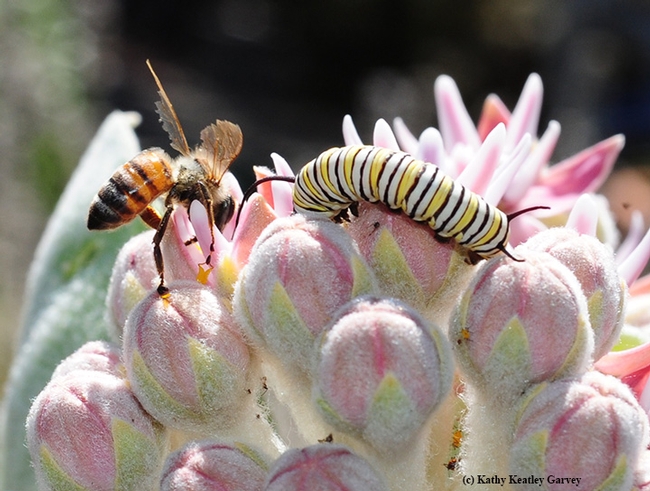

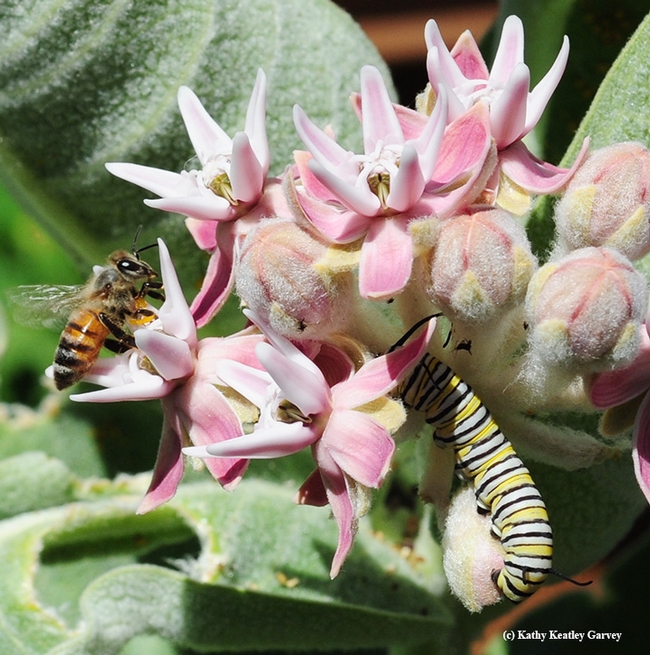
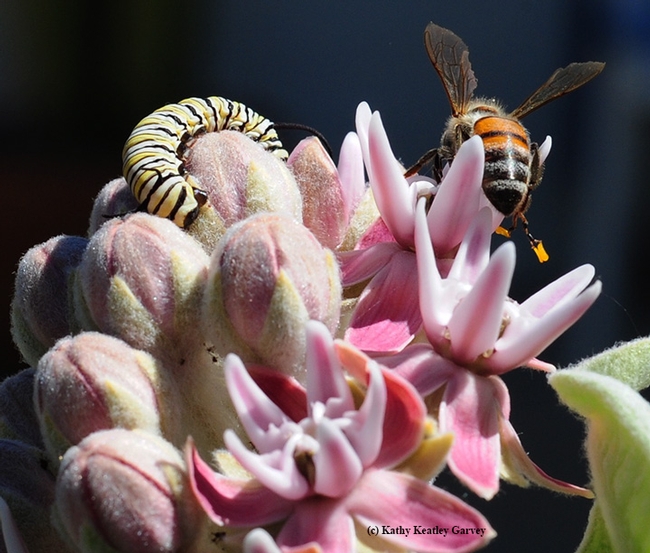
- Author: Kathy Keatley Garvey
How times change with the advancement of knowledge.
It's long been known that when honey bees—as well as other insects—get trapped in the milkweed's pollinia, or sticky mass of pollen, many perish when they are unable to free themselves.
So when we were perusing the book, ABC of Bee Culture, published in 1890 and written by noted beekeeping innovator/entrepreneur A. I. Root (1839-1923) of Ohio--with information “gleaned from the experience of thousands of beekeepers from all over the land”--we came across a surprising recommendation.
The surprising recommendation: If you want to kill off bees where they are not wanted, plant milkweed. In one reference, milkweed is described as a “useless weed.” (Actually, it's the only larval host of the monarch butterfly and without milkweed, no monarchs.)
Excerpt from ABC of Bee Culture:
"Milkweed (Asclepias cornuti). This plant is celebrated, not for the honey it produces, although it doubtless furnishes a good supply, but for its queer, winged masses of pollen, which attach themselves to the bees's feet and cause him to become a cripple, if not to lose his life. Every fall, we have many inquiries from new subscribers in regard to this queer phenomenon. Some think it is a parasite, others a protuberance growing on the bee's foot, and others, a winged insect enemy of the bee.” (Note that foragers are referred to as male, but all foragers are female.)
“It is the same that Prof. Riley alluded to when he recommended that the milkweed be planted to kill off the bees when they become troublesome to the fruit grower. The folly of such advice—think of the labor and expense of starting a plantation of useless weeds just to entrap honey bees---becomes more apparent when we learn that it is perhaps only the old and enfeebled bees that are unable to free themselves from those appendages, and hence the milkweed can scarcely be called an enemy. The appendage, it will be observed, looks like a pair of wings, and they attach themselves to the bee by a glutinous matter which quickly hardens so it is quite difficult to remove, if not done when it is first attached.”
There's a wealth of information in the encyclopedic ABC of Bee Culture, even the 126-year-old edition, but planting milkweed to kill bees and describing milkweed a "useless weed" aren't two of them.
How times change with the advancement of knowledge.
(Editor's Note: The newest edition of the ABC of Bee Culture is The ABC and Xyz of Bee Culture: An Encyclopedia of Beekeeping, 40th Edition. It's published by the A. I. Root Co.)
